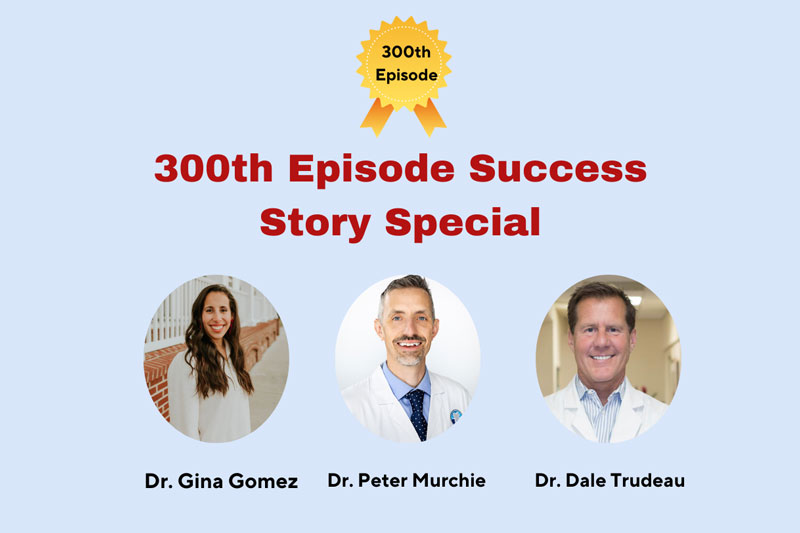Episode #302: You Can Have a Profitable Practice AND Serve Those In Need
Listen Now
Podcast: Play in new window | Download
Subscribe: RSS
Every practice has a segment of its patient base that doesn’t have insurance. Often it’s a very small segment. On average, 85% of dental practice patients come from PPO plans. In the context of this episode, we can apply Robert Cialdini’s concept of leveraging the moment with the help of six fundamental principles of influence. Gary Takacs explains how to use this concept to ask for patients’ referrals and make it three times more likely for them to say yes to your request. Listen and leverage the moment with your patients to increase patient referrals!
Naren: Welcome to another episode of the less insurance dependence podcast show. The official podcast of the reducing insurance dependence academy rid dot academy. Today’s topic is the importance of patient referrals when dropping PPO plans, the importance of patient referrals when dropping PPO plans. This is Naren, your co-host. Before we jump into the episode, I have a quick announcement to make. We have an MBA coming up a three-part MBA workshop coming up, the ten elements of a thriving practice on July 27th, 28th, and 29th, 9 hours of CE, 7 to 10 pm on the 27th, 28th, and 29th of July, and you’re going to learn the ten elements the 24 systems and most importantly Gary is going to help you with the help of 11 exercises learn how to apply this in your practice. So, if there are still seats available, the link is thrivingdentist.com forward slash MBA. Sign up, and I look forward to seeing you there. Now Gary, let’s jump into today’s topic; and this is a wonderful topic because as we are recording it right before this call, we had a wonderful conversation with a mutual client of ours and, and we talked about referrals. So, I’m really excited to talk about this topic, Gary.
Gary: Yeah, Naren, it’s very timely because of that conversation we just had, and the best way for our listeners to think about this is a saying that most people are familiar with, and the saying goes like this, birds of a feather flock together. Now Naren, is that a, a, saying you’ve heard in Canada?
Naren: yeah, I heard it growing up; I remember my mother telling me this somebody telling me this when I was a kid
Gary: my grandmother taught me that saying, and you know, growing up in Cleveland, Ohio, my grandmother taught me that. She said birds of a feather flock together. The context that my grandmother used, you know, the older I get, the smarter I realized my grandmother was now she’s been gone for many years, but she still plays an influence in my life for sure, but the context my grandmother used was Gary choose your friends wisely.
Naren: right
Gary: hang out with good people. So, birds of a feather flock together. So now, let’s extend that to the context of this podcast and our listener’s interest, which is successfully dropping PPO plans. Now every practice has a segment of their patient base that doesn’t have insurance, that doesn’t have insurance. Now often it’s, it’s, very it’s a small sliver. You know Naren when we’ve, we’ve been doing this in our webinars recently, where we do our, our, insurance write-off calculator and we tell our audience that if you don’t know what you’re writing off, we have a program a computer program that can figure that out for you. It’s called our insurance write-off calculator, and doctors will enter the information in, and then the program does its work to be able to tell doctors how much they’re actually writing off and one of the calculations that it figures is what percentage of the practice has PPO plans, what percentage of the practice, and what do we usually see Naren, what is the trend line that we normally see when we’re looking at you know dozens and dozens and hundreds of, of, those data points. We usually see that a very high
Naren: yes
Gary: percentage of the practice has PPO plans
Naren: yeah, I think we typically see like 80 percent is like the average. So, it’s around 70 to 90 percent we said that’s the range we see
Gary: you know 75 percent, 78 percent, 84 percent, I think the most we’ve seen is 92 percent.
Naren: right
Gary: but rarely do we see that number being a small percentage of patients, rarely do we see it, you know, 25 percent. We rarely see and, and, if you think about it, it makes perfect sense because if the number one way you’re getting new patients is by being listed on the PPO plans, that’s going to create a disproportionate source of new patients for your practice and, and, that’s why it becomes such a high number over time. If you’ve been a PPO office for a while, that number keeps creeping up. You know, in my own practice, when we started going out of network, it was 85 percent, it was 85 percent, and it really gives you the perspective that can I even do this when so much of my patient base, you know our PPO plans can I even do this, and we’ve talked about that we’ve addressed that in past issues but, but let’s go to the topic here. Let’s say 85 percent of your patient basis is PPO means that that 15 percent doesn’t have insurance, and so we’re going to in terms of we’re going to use a Robert Cialdini concept, and the Robert Cialdini concept is to leverage the moment. You know Robert Cialdini talks about Doctor Cialdini talks about the six fundamental principles of influence, and if you haven’t read his book or listened to his book influence and then done the follow-up, which is pre-suasion, the book pre-suasion, run don’t walk, and listen to those books read those books if you’re a reader and you’ll know a lot more about marketing than you knew before you read those books, but he’s got six fundamental principles of influence, and his point is that when you recognize those principles of influence, and you leverage the moment, you’re three times more likely to, to, receive a favorable response from your patient. So, in the context of dentistry, when you leverage the moment, you’re three times more likely for the patient to say yes, whatever it is we’re asking them for
Naren: Absolutely
Gary: if we’re asking them to schedule an appointment when you’re leveraging the moment, you’re three times more likely for them to say, of course, yes. If we’re asking them to write a google review, when we’re leveraging the moment, it’s three times more likely for the patient to, to, literally you know, write that review, and now in the context of asking for a referral, the same thing applies. They’re three times more likely. Think how powerful that is?
Naren: yeah, so what you’re saying is the moment when the patient is feeling appreciative of grateful love the moment the patient is feeling positive about your practice. That’s the moment we need to tap into and ask them.
Gary: Yeah, absolutely, you know when they are feeling part of your practice, when they’re feeling like the top of the world like I have chosen the best dental office on the planet, you know that’s when you want to leverage the moment. It sounds kind of obvious, but yes, that’s exactly what that’s about; you know, frankly, the six fundamental principles of influence are actually very obvious when you know it.
Naren: right, for example, you gave me a shot, and I didn’t feel it. I’m like, man, I’m so glad I come here because I hear going to the last dentist and, and, they verbalize it you know what this doctor gave me this amazing shot and I couldn’t feel it.
Gary: Another example is a lot of times, you know patients are feeling especially happy and at a high point emotionally after you’ve completed significant treatment.
Naren: yeah
Gary: and they’re looking in the mirror, and they’re saying, wow man, I the only regret I have is, I didn’t do this sooner how come I didn’t do this ten years ago oh doctor, you know they’re feeling like on cloud nine. So
Naren: sometimes this moment can also be created right, Gary. What I mean is you, you, taught me this. I mean, you learned it from Doctor Omar like when you know enough information about your patients, and you inquire about it. Let’s say I love gardening, and then you remember that last time I was there, I was talking about, oh kids, I’m making this up. Hey, how are your kids’ plans going? I mean, you’re like, wow, this is amazing. Here is a dentist who knows me, who likes me, who gives you who cares about me, and now I’m in cloud nine. So that moment was created.
Gary: you can go on offense or defense on this
Naren: yeah
Gary: defense as we wait for the moments to happen
Naren: right
Gary: And, and, that works, but I’d rather go on offense. I’d rather make these moments happen, so let’s put this together in a system, Naren, because it’s one thing to kind of have it in your mind and be somewhat aware of it, but in terms of it actually happening as a system, it is much better when we systematize it. A classic example of that Naren is when we decided that we would make even evening week care calls. This goes back to 07 in my practice; by the way, if you’re following along and you know the script we converted those evening we care calls to evening we care contacts in 2019, where we now do those by text message we found that there it’s, it’s, been just as effective and more efficient to do them by text message, but when we made the system up in 2007, I sat down with Paul, and I said let’s do this, let’s have you make an evening we care to call to any patient on the schedule today that received an injection, any patient received an injection because now it wasn’t up to Paul to arbitrarily randomly decide if this patient would appreciate a call or not.
Naren: Right
Gary: simply going to call every patient that got an injection, and we would do that evening we care call. So that’s the concept of systematizing because now it’s gone from a random activity to a systematized activity that happens on a regular basis, makes all the difference in the world. So here are some pieces of the system that I would suggest in terms of looking for patients to ask for referrals. Have someone show up to your team meeting, one of your team members shows up to your morning huddle with highlighted names of every patient on your schedule today that does not have insurance, that does not have insurance. So, you might be seeing 20 patients. I’ll just make up a number. You might be seeing 20 patients, and maybe four of them today don’t have insurance. So those are the highlighted names. So, step one, you know, shows up with this list. Step two look at those names and identify any patients who you think would be a good referral source, you know the happy, outgoing gracious, you know the ones that are very appreciative, and maybe if there are four names on the list, there’s three of them that oh yeah these would be perfect. So the next step is, determine who’s going to ask for the referral because if you have a team of eight and the doctor nine, you don’t want nine people asking for a referral. I think that would be harassment, would you agree, Naren?
Naren: yes
Gary: It would certainly be
Naren: Yes
Gary: it would be less effective
Naren: Yes
Gary: if it’s done that way, it’ll feel artificial and contrived, so identify who’s going to ask and usually it comes up organically like you know your Hygienist Kelly might say, oh I’ll ask Maria you know we go to the same yoga studio I see her three times a week we’re buddies, I’ll ask Maria, and if you if it doesn’t come up organically if someone doesn’t volunteer, one thing I would encourage you to do in your practice is to identify your team member who has the highest I in the disc, they’re, they’re, outgoing gregarious social they’re the ones that are extroverted and, and, have that person on your team ask because that’s going to be a natural process for that person. Does that make sense, Naren?
Naren: absolutely, absolutely,
Gary: And then let’s talk about what to say and again this has to be done individually, it’s not going to be scripted it has to be done relevant to the patient in the example that I gave where Kelly said I’m, I’m, going to ask maria because we go to the same yoga studio, I see her three times a week outside of practice. Kelly can say something like this, maria, I have to tell you, I sure love seeing you on my schedule. When I see you on my schedule, I know I’m going to have an amazing day. Now that has to be genuine. If that’s not the sentiment, then come up with something else, and by the way, you’re going to share a tip-in just a minute about some other ways we can kind of leverage this, but that might be the way we ask, and then we would say to maria, you know maria I would love to see more people in our practice like you, that would make it amazing to have more people in our practice that are just like you. Now pause for just a second how does maria feel right now, Naren.
Naren: she’s in cloud nine she’s, she’s, feeling appreciated she’s feeling you know validated like you know like because as humans today, especially in a world of devices, we don’t appreciate people and acknowledge people
Gary: How often does this kind of stuff happen
Naren: exactly
Gary: and now she feels like, oh thank you, Kelly, and then Kelly can make the request, and the request is if you know people that would appreciate how we take care of patients, please recommend our office to them. We will always make room we welcome new patients, Maria, and we’ll always make room for friends of yours. They’ll be a part of our VIP patient base. Hey, thanks in advance thanks in advance. Now, so we make her feel very special now, you can start to identify people as well, and then I want to flip it over to you to talk about some ways we can make this even more effective; we want to identify some people. Three groups of people that don’t have insurance jump to mind. Retirees Naren do you think if we had an audience listener you know on our recording right now and I asked that doctor do you have any retirees in your practice? What do you think every doctor on the planet is going to say
Naren: Absolutely. I mean, I think every single practice, you know, I bet can find many, many, many, retirees in their practice absolutely.
Gary: They can probably think of, you know, 20 names right off the top of their head
Naren: yeah
Gary: so, retirees, remember, you know in the old days when you were retired, your benefits stayed with you, and you had benefits for life. Well, that doesn’t happen anymore, so think about retirees as being good candidates—the opposite end of this age spectrum, millennials. Millennials, oftentimes millennials haven’t reached the point in their career where they’re accorded benefits. They don’t have insurance, and then another group gig economy workers are independent contractors’ freelancers. They’re Uber drivers, Lyft drivers, Airbnb owners, and if we have a relationship-driven practice, we should know what they do for a living, right?
Naren: yeah
Gary: and then a third group would be small business owner’s small business owners could be another group to target now Naren talk about how the concept of liking one of the six principles of Robert Cialdini principles of influence talk about how liking can apply here and how our listeners can easily apply that through using social media
Naren: yeah, absolutely, you know I think the world has changed in the sense like we used to have a time I still remember it where we used to send birthday cards. I did this 25 years ago would you know to remember everyone’s birthday and I would go to the shop buy a birthday card you know go to the post office mail it. Then it turned into, you know, phone calls where you would wish people on the phone and then now we live in a time in an age where most of us with each other on social media like Facebook because it’s convenient it’s easy Facebook will even remind you, it’s Gary’s birthday today. So, things have changed doesn’t mean that we don’t wish people on birthdays just how we do it has changed just because you know as humans, we like easier, simpler ways of doing things and almost like done for you and Facebook reminds it reminds you, so you don’t have to even think about it you don’t have to go to the post office you don’t have to find the postcard. The same thing is happening here; I think you know in terms of referrals in the old days’ referrals were like I remember when I needed something I had a tech guy I had in my phone. I would call him for anything tech. Oh, I’m thinking about this tv I’m thinking about this camera, and he would tell me, and I have a health guy in my pocket, and I call him for health stuff. So, we have we all had somebody we go to because remember 20 years ago Google didn’t exist. So that was our way of getting the best information from someone we trusted. Today that’s very different, so a lot of the referrals are happening virtually, and let me give you an example. So, let’s say I’m an I’m you know I’m a man 45 years old, brown-skinned and I post on my social media, I’m holding a digital sign the digital sign says I love my dentist and my dentist posted it he tagged me now my friends say it now let’s say if somebody else who is thinking about getting a dentist, especially if that person is similar to me, maybe in terms of either age may be in terms of gender or maybe in terms of
Gary: And the other example that you use Naren is so perfect in terms of perfect because you’re one of those four groups that we identified
Naren: yeah
Gary: you want to do business
Naren: yes
Gary: and so many people on your social media accounts, not all, but many will also be small business owners; why? birds of the feather flock together
Naren: Flock together exactly. They’re like my friends are seeing you know want to keep in touch with me, I’ll see what I’m up to and yeah absolutely totally, totally, 100 percent agree. So now it’s easy I don’t even do anything so at that moment so the patient is getting talked about the moment when the patient is feeling grateful appreciate it at that moment one of the things you can ask for is instead of saying can you refer me to somebody you can say hey do you mind if you take a picture patient says absolutely no one absolutely you flip we have a tool called my digital signboards, but you could use anything it could be a physical sign, and the sign could be I love my dentist you know no cavities please you know just fun stuff right you can have different, different, signs and I’m just holding a sign and the team is standing his team member is standing next to me the hygienist and used to have a picture and then what you do is you post it on your social media, and you ask the patient’s permission of course, and then you tag the patient. One other thing you can do is start collecting these pictures and put them on your website. You can have a page called happy patients, and that page can have pictures of different people, different skin colors, different age groups different you know, male versus female you know family versus you know individuals. When you when I see someone, who looks like me, I subconsciously believe, you know, going back to that statement birds of a feather flock together, I subconsciously believe I’m going to be happy because someone like me is happy.
Gary: I’m in that club
Naren: yeah, I’m in that club, and a lot of times this is why you know if you don’t do this what happens is they will assume you can’t help them let’s say the doctor is 30 years old I am a 65-year-old female I think you know maybe he won’t understand me, but when I see four other 60-year-old females like me I’m like yeah these people like him I’m going to like him. So, it’s kind of not only it helps you get new patients through referrals but also it helps you, you, know helps you, you, know help people who otherwise wouldn’t have come to come to your practice. So, I think these are great ideas, Gary.
Gary: Yeah, I’m, I’m, loving the context of this episode for sure, and watch what happens when you start leveraging the moment, and you start gaining referrals of other people who don’t have insurance. Remember, every time we bring in a new patient who doesn’t have insurance, we’re not going to hear two questions, are you in my network? They’re never going to ask that question because they have no network, and then secondly, they’re not going to ask when you make treatment recommendations; they’re not going to ask is this covered by my insurance, and all of that leads to a happier practice. Well, as we come to the finish line in this episode, I want to come back full circle to something you mentioned in the opening Naren, and that is the digital association that you and I created called RIDA, R-I-D-A, and it’s both a play on words we want to help you get rid of insurance.
Naren: yes
Gary: pardon the grammatical errors there, but we’ll help you get rid of the insurance; but it’s also an acronym, and it stands for reducing insurance dependence academy. Consider this an invitation to come join our club if you want to be birds of a feather flock together and you want to hang with other dentists and team members that are successfully dropping insurance, come join our association and guess what I think we have a rather compelling financial incentive for you. Your membership is a gift from Naren, and It’s free. Come join us, and you can go to www.rid.com. Come join us. We’d love to have you be part of our club birds of a feather flock together. I think you’ll enjoy hanging with the members. We’ve got all kinds of things planned in the future for that academy, that association. It’s the first digital association in dentistry. Come join us, and I think that’ll help support all the work that you’re doing in your practice to successfully reduce insurance dependence. On that note, let me simply say thank you, and I’m going to follow true to the theme of this episode. We talked about referrals. We welcome new listeners here at the less insurance dependence podcast. If you know of a colleague that you think could benefit from our content, please tell them about us. Let them know they can find the podcast on our website unless insurance dependents dot com. They can find it on iTunes, google play, Spotify, amazon music, apple music, or wherever they get their podcast and let me simply say thank you in advance. We appreciate your support.
 One of Gary's most significant achievements as a dental practice management coach is transforming his own practice, LifeSmiles, from one that was infected with PPO plans, no effective marketing strategy, and an overhead of 80% to a very successful dental practice that is currently one of the top-performing practices in the US.
One of Gary's most significant achievements as a dental practice management coach is transforming his own practice, LifeSmiles, from one that was infected with PPO plans, no effective marketing strategy, and an overhead of 80% to a very successful dental practice that is currently one of the top-performing practices in the US.
 As CEO of Ekwa Marketing, Naren has over a decade of experience working with dental practices and helping them attract the ideal type of patients to their practices. It is his goal to help dentists do more of the type of dentistry they love with the help and support of effective digital marketing.
As CEO of Ekwa Marketing, Naren has over a decade of experience working with dental practices and helping them attract the ideal type of patients to their practices. It is his goal to help dentists do more of the type of dentistry they love with the help and support of effective digital marketing.



